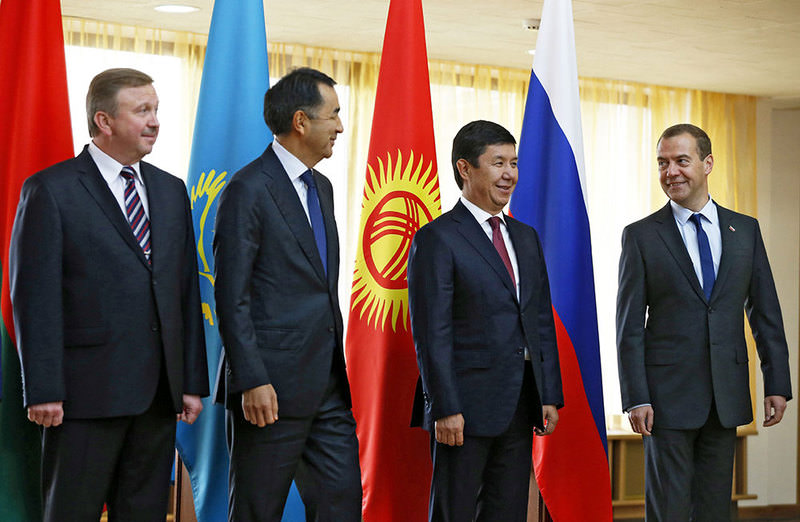Re: Eurasian Customs Union
RUSSIA TO INTRODUCE TURKIC 'ALTYN' IN EURASIA TO CHALLENGE EURO, DOLLAR
Daily Sabah, Turkey
Sept 10 2015
DAILY SABAH WITH WIRES
ISTANBUL
Belarusian PM Andrei Kobyakov, Kazakhstan's 1st Deputy PM Bakytzhan
Sagintayev, Kyrgyzstan's PM Temir Sariyev and Russian PM Dmitry
Medvedev pose for a group photo during the meeting of EAEC in Grodno,
Belarus, September 8 (EPA Photo).
Russia's President Vladimir Putin has submitted a bill to the
Parliament on August 28 to reduce the usage of the U.S. dollar and
euro in transactions between the Commonwealth of Independent States
(CIS) members amid deepening worries of the global economy, falling oil
prices and the West's sanctions aiming to cripple the Russian economy.
The idea of a common currency has long been discussed for former
Soviet republics and Asian economies, which are now organized under
international organizations such as the CIS, Shanghai Cooperation
Organization (SCO) and Eurasian Economic Union (EEU). The latter,
which is comprised of Armenia, Belarus, Kazakhstan, Kyrgyzstan and
Russia, is more closer to switch to a common currency than the rest,
and the proposed name, "altyn," is familiar for Turkish speakers.
Several news outlets from the region reported that the proposed name
for the common currency will be a Turkic one, "altyn," the word for
gold in Turkic languages, which is planned to be introduced by 2020
or 2025.
The article below published by Radio Free Europe / Radio Liberty,
explains why this name was chosen and its historical significance.
Goodbye Dollar, Hello Altyn? In Ex-Soviet Union, Possible Future
Currency Has Rich Past - by Merhat Sharipzhan
When Russian President Vladimir Putin submitted a bill aimed to help
de-dollarize the post-Soviet space, it came as no surprise for many
in the former U.S.S.R.
On August 28, Putin asked parliament to ratify a treaty among members
of the Commonwealth of Independent States that would expand the use
of their national currencies -- instead of the dollar or euro --
in foreign trade payments and financial services.
The move came as the ruble and other currencies across the region
continue to suffer. It followed months of calls in Russia for the
creation of a single currency for the Eurasian Economic Union, which
comprises Russia, Armenia, Belarus, Kazakhstan, and Kyrgyzstan.
The proposed name: the "altyn."
For many, altyn sounds less Russian than Turkic -- an impression that
is completely accurate and raises many questions.
The word, although not Slavic, is inseparable from the history of
Russian statehood, as are many other Turkic-origin words related to
the Russian government and financial system.
So, why altyn?
Starting in the 15th century, the altyn was a major currency in what
we today call Russia.
Many relate its name to the Turkic word "altyn" -- gold.
But there is another explanation. If we look at the exchange rate
of the altyn against another former Russian monetary unit, the denga
(also Turkic: tanga or tenge), we will see that one altyn was equal
to six half-dengas. Six in Turkic is "alty" -- and here lies the root
of the currency's name.
The Golden Horde, of which many Russian principalities and territories
were part -- and of which Muscovite Russia was certainly a successor --
had half-denga coins.
Denga, like altyn, is of Turkic origin. The Russian word "dengi" --
money -- is derived from denga.
The altyn and the denga circulated in Russia for centuries, until the
end of the 18th century. Later, the name altyn went completely out of
usage after the image of St. George on a horse with a spear started
being engraved on the back of the coin. Spear is "kop'ye" in Russian,
and the word "altyn" was gradually replaced by a derivative of kop'ye
-- "kopeyka" or kopeck.
The half-kopeck coin survived the Russian Revolution and was in use
in the Soviet Union until 1928.
Another trace of the altyn, the three-kopeck coin, continued to
circulate until the Soviet breakup of 1991.
Echoes of the altyn also rang out in the Russian word "pyatialtynnik"
or "pyatialtynny" -- meaning "five altyns" and used as a synonym for
a 15-kopeck coin.
As for denga, it is the root not only of the Russian "dengi" but also
the national currency in Turkic-speaking Kazakhstan -- the tenge. Over
in Turkmenistan, another Turkic-speaking Central Asian nation, the
tenge is the smallest monetary unit, with 100 tenges making one manat.
The smallest monetary unit in Kazakhstan is called the "tyin" --
a Turkic word that was used by tens of millions of Soviet citizens
for the Russian kopeck.
In the Russian language, it was preserved in "poltinnik" (half-a-tyin),
which was used originally for 50 kopecks (half a ruble), but in the
modern Russian language is used to replace the word "fifty" -- as in
50 rubles, or even $50.
And someone who turns 50 in Russia might say, "Mne poltinnik stuknul"
-- I hit 50 (or, more literally, 50 hit me).
While history is often rewritten to serve political aims or conform to
current societal preferences, languages still carry historic "proofs."
The Russian history strongly connected with the history of the
Turkic-speaking Volga area, and many regions of the North Caucasus and
Central Asia, is a part of the common history of the former subjects
of the Golden Horde.
After all, such important Russian words related to statehood as "kazna"
(state treasury), "kaznachei" (accountant), "tamozhnya" (customs) --
from "tamga" (mark or stamp) -- are remnants of the state system of
the empire called the Golden Horde.
Others include "yarlyk" (label), "tyurma" (prison), "karaul" (guard),
"yamshchik" (postman), and many more.
We shall see whether the altyn will return to the former Soviet space.
Or should we say the post-Golden Horde space?
RUSSIA TO INTRODUCE TURKIC 'ALTYN' IN EURASIA TO CHALLENGE EURO, DOLLAR
Daily Sabah, Turkey
Sept 10 2015
DAILY SABAH WITH WIRES
ISTANBUL
Belarusian PM Andrei Kobyakov, Kazakhstan's 1st Deputy PM Bakytzhan
Sagintayev, Kyrgyzstan's PM Temir Sariyev and Russian PM Dmitry
Medvedev pose for a group photo during the meeting of EAEC in Grodno,
Belarus, September 8 (EPA Photo).
Russia's President Vladimir Putin has submitted a bill to the
Parliament on August 28 to reduce the usage of the U.S. dollar and
euro in transactions between the Commonwealth of Independent States
(CIS) members amid deepening worries of the global economy, falling oil
prices and the West's sanctions aiming to cripple the Russian economy.
The idea of a common currency has long been discussed for former
Soviet republics and Asian economies, which are now organized under
international organizations such as the CIS, Shanghai Cooperation
Organization (SCO) and Eurasian Economic Union (EEU). The latter,
which is comprised of Armenia, Belarus, Kazakhstan, Kyrgyzstan and
Russia, is more closer to switch to a common currency than the rest,
and the proposed name, "altyn," is familiar for Turkish speakers.
Several news outlets from the region reported that the proposed name
for the common currency will be a Turkic one, "altyn," the word for
gold in Turkic languages, which is planned to be introduced by 2020
or 2025.
The article below published by Radio Free Europe / Radio Liberty,
explains why this name was chosen and its historical significance.
Goodbye Dollar, Hello Altyn? In Ex-Soviet Union, Possible Future
Currency Has Rich Past - by Merhat Sharipzhan
When Russian President Vladimir Putin submitted a bill aimed to help
de-dollarize the post-Soviet space, it came as no surprise for many
in the former U.S.S.R.
On August 28, Putin asked parliament to ratify a treaty among members
of the Commonwealth of Independent States that would expand the use
of their national currencies -- instead of the dollar or euro --
in foreign trade payments and financial services.
The move came as the ruble and other currencies across the region
continue to suffer. It followed months of calls in Russia for the
creation of a single currency for the Eurasian Economic Union, which
comprises Russia, Armenia, Belarus, Kazakhstan, and Kyrgyzstan.
The proposed name: the "altyn."
For many, altyn sounds less Russian than Turkic -- an impression that
is completely accurate and raises many questions.
The word, although not Slavic, is inseparable from the history of
Russian statehood, as are many other Turkic-origin words related to
the Russian government and financial system.
So, why altyn?
Starting in the 15th century, the altyn was a major currency in what
we today call Russia.
Many relate its name to the Turkic word "altyn" -- gold.
But there is another explanation. If we look at the exchange rate
of the altyn against another former Russian monetary unit, the denga
(also Turkic: tanga or tenge), we will see that one altyn was equal
to six half-dengas. Six in Turkic is "alty" -- and here lies the root
of the currency's name.
The Golden Horde, of which many Russian principalities and territories
were part -- and of which Muscovite Russia was certainly a successor --
had half-denga coins.
Denga, like altyn, is of Turkic origin. The Russian word "dengi" --
money -- is derived from denga.
The altyn and the denga circulated in Russia for centuries, until the
end of the 18th century. Later, the name altyn went completely out of
usage after the image of St. George on a horse with a spear started
being engraved on the back of the coin. Spear is "kop'ye" in Russian,
and the word "altyn" was gradually replaced by a derivative of kop'ye
-- "kopeyka" or kopeck.
The half-kopeck coin survived the Russian Revolution and was in use
in the Soviet Union until 1928.
Another trace of the altyn, the three-kopeck coin, continued to
circulate until the Soviet breakup of 1991.
Echoes of the altyn also rang out in the Russian word "pyatialtynnik"
or "pyatialtynny" -- meaning "five altyns" and used as a synonym for
a 15-kopeck coin.
As for denga, it is the root not only of the Russian "dengi" but also
the national currency in Turkic-speaking Kazakhstan -- the tenge. Over
in Turkmenistan, another Turkic-speaking Central Asian nation, the
tenge is the smallest monetary unit, with 100 tenges making one manat.
The smallest monetary unit in Kazakhstan is called the "tyin" --
a Turkic word that was used by tens of millions of Soviet citizens
for the Russian kopeck.
In the Russian language, it was preserved in "poltinnik" (half-a-tyin),
which was used originally for 50 kopecks (half a ruble), but in the
modern Russian language is used to replace the word "fifty" -- as in
50 rubles, or even $50.
And someone who turns 50 in Russia might say, "Mne poltinnik stuknul"
-- I hit 50 (or, more literally, 50 hit me).
While history is often rewritten to serve political aims or conform to
current societal preferences, languages still carry historic "proofs."
The Russian history strongly connected with the history of the
Turkic-speaking Volga area, and many regions of the North Caucasus and
Central Asia, is a part of the common history of the former subjects
of the Golden Horde.
After all, such important Russian words related to statehood as "kazna"
(state treasury), "kaznachei" (accountant), "tamozhnya" (customs) --
from "tamga" (mark or stamp) -- are remnants of the state system of
the empire called the Golden Horde.
Others include "yarlyk" (label), "tyurma" (prison), "karaul" (guard),
"yamshchik" (postman), and many more.
We shall see whether the altyn will return to the former Soviet space.
Or should we say the post-Golden Horde space?










Comment